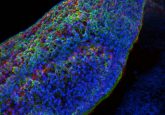Gold–diamond nanodevice developed for hyperlocalized cancer therapy

Precise targeting of cancer cells during treatment is challenging due to their small size. However, Pei-Chang Tsai and colleagues from the Institute of Atomic and Molecular Sciences at the Academia Sinica (Taipei, Taiwan) have developed an advanced solution for this problem. By using current techniques in a novel combination, the new approach may potentially be applied to and aid thermal cancer therapy.
The study, recently published in EPJ Quantum Technology, reports on an improved sensing technique for temperature sensing and nanometer-scale heating. By attaching gold nanorods to the surface of a diamond nanocrystal using a chemical method, the researchers have developed a new biocompatible nanodevice that is able to deliver extremely localized heating from a near-infrared laser aimed at the gold nanorods, while simultaneously accurately sensing temperature with the nanocrystals.
The researchers’ laboratory specializes in making bright fluorescent diamond nanocrystals that contain a high concentration of punctual color center defects, which, when exposed to green light, emit a fluorescent red light that is useful for subcellular imaging. Via optical manipulation and detection, these centers can also be turned into hypersensitive nanoprobes that can detect temperature and magnetic field.
The introduction of gold nanoparticles to the nanocrystal makes it possible to convert incoming laser light into extremely localized heat – the gold nanoparticles are therefore capable of acting as switchable nanoheaters for therapies based on delivering precise and intense heat to cancer cells, with the laser providing the energy source.
The study demonstrates the possibility of using diamond nanocrystals as hypersensitive temperature sensors with a high spatial resolution (10–100 nm) to monitor how much heat is delivered to cancerous cells.
Source: Springer press release



